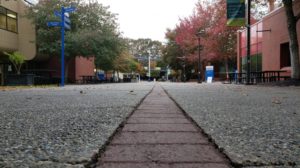On Monday, July 5, the provincial government released final guidelines for a full return to campus in the fall. The provincial COVID-19 Return-to-Campus Guidelines say that on September 7 at the earliest, masks will be a personal choice on campuses, there will be normal social contact, and there will be no occupancy limits for workspaces. The guidelines also state that by that date at the earliest, all campus spaces will be fully re-opened, including events, parties, and student group activities.
Camosun director of facilities services Ian Tol says that while some people might feel differently, the general feeling on campus is that “we’re quite excited to be back,” but some protective measures will remain in place.
“I think a lot of students are going to be very happy about being able to be back in class,” he says.

Tol calls the effort of keeping campus safe throughout the pandemic an “all hands on deck” effort. While there was COVID-19 exposures reported at Camosun, there were no outbreaks, which Tol says was the result of an “all-consuming” effort to keep campus as safe as possible. Tol adds that although the government is saying all physical barriers can be removed in September, there are certain ones Camosun is not removing.
“By September 7, when school starts, it’s anticipated right now that pretty well all the restrictions are removed—so having arrows for flow and those kinds of things, and where we’ve… restricted entry points and exit points in buildings to avoid cross traffic—that’s all going to be removed. The one thing that we will keep in place—it’s not a requirement, but we’re doing it, sort of as an extra measure and also to provide our employees that extra sense of security and feeling safe—is that in service areas, we’re keeping most of the plexiglass in place in areas where employees are servicing multiple students… If we find over time that it’s no longer needed, or no longer wanted, we can always remove it.”
Hand sanitizer will remain available in current locations, says Tol.
“We’re going to continue to keep those available,” he says. “Although we had hand sanitizer available in a lot of places before COVID, we’ve definitely expanded that. It’s available in every classroom, washrooms, and near entrances.”
Tol says that with more online courses offered in the fall than there were before the pandemic, the long-term impact on space and employees working from home remains to be seen, but the college is in the process of figuring that out.
“Where things do become more commonplace online, it’ll have an impact on our space use, for sure,” he says. “Use of the campus, related services… It could have an impact on parking in a positive sense in that it might be less busy. It could provide opportunities in terms of space use where we have less need for space use, so more opportunity to either adjust or make different use of our space. I do think there’s going to be a bit of an impact, but it’s hard to say [how much]. The expectation, as far as faculty and staff go, [is] that everybody comes back to campus over the period of August to the end of September while the institution develops some guidelines around what it might mean to work from home.”
Tol says that Camosun is following the BC COVID-19 Return-to-Campus Guidelines, and that keeping campus safe for everyone is a team effort that the college has excelled at.
“In order for the college to remain operational and to be able to offer courses and to ensure that the staff and faculty and whatnot were safe was a real team effort from basically everyone across the college,” he says. “I’m really proud of the institution and how we pulled together.”
